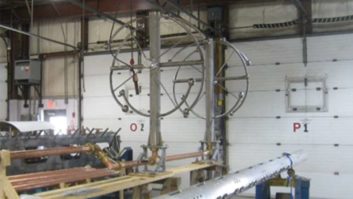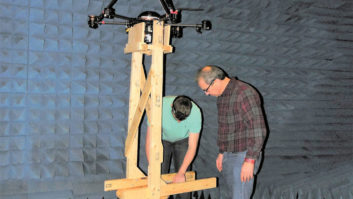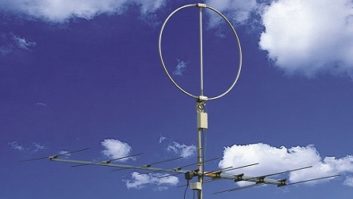Testing Antennas with a Network Analyzer
Jan 6, 2013 9:00 AM, By Jeremy Ruck, PE
No doubt one of the most revolutionary tools for the RF side of broadcasting was the advent of the network analyzer. Prior to its invention, measuring the response of an antenna system was more or less limited to using a bridge or vector voltmeter, a swept spectrum analyzer with return loss bridge, or the reflected power meter on the transmitter. Each of these methods had limitations that were ultimately eliminated with the network analyzer.
Using a bridge or vector voltmeter, while reasonably accurate at measured frequencies, was very time consuming. Graphical interpolation between the measurement frequencies often induced substantial error in the measured data, although this was less of an issue for FM antennas and shorter line runs. Spectrum analyzer methodologies are quicker and provide greater resolution and less error, but are unable to present the entire story. You may be able to determine that a problem exists; however, where that problem is located typically remains a mystery. Finally, using the reflected power meter to tune an antenna is an absolute no-no. While the transmitter meter is useful for noting changes, this methodology is wholly unsuitable for any meaningful adjustment, and can mistune the antenna substantially enough to result in a combustible failure.
Analyze this
Network analyzers come in two flavors: scalar and vector. The scalar network analyzer provides essentially the same information as a swept spectrum analyzer with a return loss bridge, and is thus not as robust a tool as its big brother the vector network analyzer or VNA. Vector analyzers measure both magnitude and phase of the response, from which all of the important other data formats can be mathematically calculated.
The basis of the calculations in the VNA is S-parameters. S-parameters work by characterizing a network, in this case an antenna or RF system, through the use of matched loads instead of open and/or short circuit conditions. It is much simpler to characterize a resistive load across a wide range of frequencies than it is to accurately represent a true open or short circuit condition. For broadcasting applications we typically are interested in the S11 and S12 cases. The S12 case arises when examining the insertion characteristics of filters or combiners, and is the response looking from port 1 through port 2 of the system. The S11 case is the response when the reflected signal at the input is compared to the incident signal, which is the measurement mode used when viewing what is seen by the transmitter.
The stock VNA will usually only provide information in the frequency domain. A plot in the frequency domain will have frequency on the horizontal or X axis and the magnitude of a particular quantity on the Y or vertical axis. So just off the shelf we can easily view formats such as VSWR, return loss, the linear magnitude of the reflection coefficient, and phase. When the magnitude and phase are combined, we are able to look at polar return loss and the Smith chart. These latter two formats will qualitatively indicate which end of the system a problem is occurring. Indeed with some experience this information can be gleaned from the Cartesian VSWR and return loss plots. The problem of course is where exactly in the system is the problem occurring?
The time domain option available on most modern vector analyzers solves this issue. In the time domain mode, the horizontal axis of Cartesian plots becomes time, while the vertical axis remains in terms of magnitude. Since it takes a finite amount of time for a signal to propagate through a transmission line, a particular “time” of interest is directly relatable to distance down the line. The time domain information is mathematically generated through the application of the inverse Fourier transform to the magnitude and phase acquired at each individual swept frequency. The result is that through the proper selection of measurement frequencies, an issue in a system can be located with very good accuracy.
To adequately depict the condition of an antenna system both the frequency and time domain must be considered. Frequency domain data provides a view of what the transmitter is actually seeing. The time domain data allows anomalies in the transmission line and the magnitude of the far end reflection, which was very important in analog television, to be quantified.
– continued on page 2
Testing Antennas with a Network Analyzer
Jan 6, 2013 9:00 AM, By Jeremy Ruck, PE
Being analyzed
Since using a network analyzer is a mature process, there has been plenty of time to develop techniques to adequately characterize an antenna system. Both manufacturers and consulting engineers have contributed to this process. Although you will typically see variances in the plots presented, most operators familiar with an analyzer’s use will tend to follow a certain pattern in the data they acquire.
When sweeping an FM system I will typically look at the VSWR and return loss across a 1MHz span centered on the carrier frequency as well as across the entire FM band. These techniques illustrate the system response within the occupied bandwidth of the FM channel in detail as well as illustrate that the system truly has the minimum VSWR near the frequency of operation and not somewhere else in the band. The frequency domain plots are then rounded out with either a polar return loss or Smith chart across 1MHz to demonstrate a decent match is occurring at both ends of the system.

Figure 1. Frequency domain VSWR of an FM antenna. Click to enlarge.
Following these measurements, I switch over to the time domain to illustrate the condition of the transmission line. Under this technique a transformed span of 100MHz width is utilized as is a wider span of around 350MHz. Both spans will illustrate the magnitude of reflections at connectors, while the wider span will actually illustrate deformations to line or in the case of rigid line the standoff insulators in a stick. Normally the VSWR at these locations should be 1.008 or less.

Figure 2. Wideband time domain VSWR of an FM antenna. Click to enlarge.
To wrap up, the plots illustrate a portion of the data acquired during the recent checkout of an FM antenna system. Figure 1 illustrates the frequency domain VSWR of the antenna system across 1MHz centered on the frequency of operation. Figure 2 illustrates the wideband time domain VSWR of the system. Figure 1 illustrates that the carrier VSWR is 1.02, and demonstrates that within 500kHz either side of the carrier a value of 1.10 is not exceeded. It should be noted that the minimum VSWR lies a little above the carrier frequency, which is preferable in areas where antenna icing can occur. The time domain plot illustrates three small reflections near the midpoint of the transmission line. These anomalies are due to a slight deformation of the transmission line resulting from routing around an existing antenna. The maximum VSWR in this area of 1.004 is most acceptable, and is less than that which would typically result at the connection of two transmission line flanges. This plot does not illustrate regular repetitive flange reflections, which is consistent with the fact that the transmission line was semi-flexible coaxial cable.
The network analyzer is without a doubt one of the most elegant pieces of test equipment. It is undeniable that having your system initially and regularly swept is an expense. That expense is, however, good insurance, and will in the end be less costly than unscheduled system repairs.
Ruck is the principal engineer of Jeremy Ruck and Associates, Canton, IL.
January 2013
The studios of JENNiRADIO, making HD Radio more than just a jukebox, testing antennas with a network analyzer, and Field Reports on the Tieline Report-IT and Deva Broadcast SmartGen Mini….







